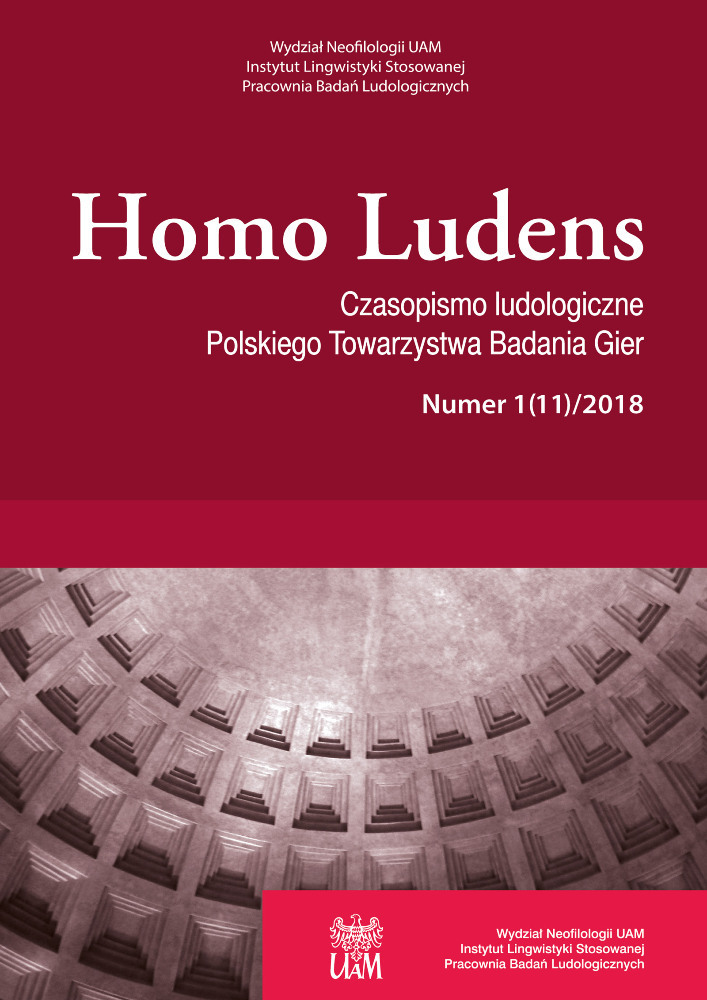Abstract
The article focuses on worldbuilding techniques used in The Witcher 3: Wild Hunt in order to create a self-contained fictional world. Firstly, an overview of the characteristics of game spaces is provided. Secondly, following a brief introduction to Andrzej Sapkowski’s fiction, the article discusses the design methods the game uses for representing topography, architecture, human and nonhuman activity, as well as for providing background information about various locations. It is concluded that the game space may be seen as an independent ontological construct and not only a framework for gameplay.
References
Aarseth, E. (2007). Allegories of Space. The Question of Spatiality in Computer Games. In Borries, F., et al. (Eds.). Space Time Play. Computer Games, Architecture and Urbanism: The Next Level (p. 44–60). Basel: Birkhäuser Publishing.
Adams, W. E. (2003). The Construction of Ludic Spaces. Online: https://pdfs.semanticscholar.org/c898/00458c6e1ec6f1ef308c6b34c3f0339dbd84.pdf.
Bereś, S., Sapkowski, A. (2005). Historia i fantastyka. Warszawa: SuperNowa.
Garda, M. (2010). Gra The Witcher w uniwersum Wiedźmina. Homo Ludens, 2(1). Online: http://ptbg.org.pl/HomoLudens/vol/2/.
Gemra, A. (2001). Fantastyka po polsku. Kilka uwag nad twórczością Andrzeja Sapkowskiego. Europa Orientalis, 20(1), 167–185.
Iser, W. (1995). Interaction Between Text and Reader. In: A. Bennett (Ed.), Readers and Reading (p. 20–31). London: Longman.
Jenkins, H. (2002). Game Design as Narrative Architecture. Online: http://paas.org.pl/wp-content/uploads/2012/12/09.-Henry-Jenkins-Game-Design-As-Narrative-Architecture.pdf
Jenkins, H. (2006). Convergence Culture: Where Old and New Media Collide. New York: NYU Press.
Juul, J. (2005). Half-real: Video Games between Real Rules and Fictional Worlds. Cambridge: MIT Press.
Kaczor, K. (2006). Geralt, czarownice, wampir. Recykling kulturowy Andrzeja Sapkowskiego. Gdańsk: słowo/obraz terytoria.
Klepek, P. (10 June 2015). How The Witcher 3’s Developers Ensured Their Open World Didn’t Suck. Kotaku. Online: http://kotaku.com/how-the-witcher-3s-developers-ensured-their-open-world-1735034176.
Kuster, M. (2015). Sylwa, palimpsest, intertekst. Modele zapożyczeń intertekstualnych w „Sadze o Wiedźminie”. In: R. Dudziński, J. Płoszaj (Eds.), Wiedźmin – bohater masowej wyobraźni (p. 9–20) Wrocław: Stowarzyszenie Badaczy Popkultury i Edukacji Popkulturowej „Trickster”. Online: http://tricksterzy.pl/download/wiedzmin-polski-fenomen-popkultury/.
Manovich, L. (2001). The Language of New Media. Cambridge: MIT Press.
Nitsche, M. (2008). Video Game Spaces: Image, Play and Structure in 3D Game Worlds. Cambridge: MIT Press.
Purchase, R. (07 November 2012). Ever wondered what the author of The Witcher books thinks about the games? Eurogamer.net. Online: http://www.eurogamer.net/articles/2012–11–06-ever-wondered-what-the-author-of-the-witcher-books-thinks-about-the-games.
Thon, J. N. (2009). Computer Games, Fictional Worlds, and Transmedia Storytelling: A Narratological Perspective. Online: https://www.academia.edu/3418208/Computer_Games_Fictional_Worlds_and_Transmedia_Storytelling._A_Narratological_Perspective.
How long is The Witcher 3: Wild Hunt? – HLTB. Online: https://howlongtobeat.com/game.php?id=10270.
Wolf, M. J. P. (1997). Inventing Space: Toward a Taxonomy of On- and Off-Screen Space in Video Games. Film Quarterly, 51(1), 11–23.
Wolf, M. J. P. (2012). Building Imaginary Worlds: The Theory and History of Subcreation. New York: Routledge.
Wróblewska, A. (2016). Jak napisać bestseller? O genezie popularności Wiedźmina z perspektywy socjologii literatury In: R. Dudziński, J. Płoszaj (Eds.). Wiedźmin – Polski fenomen popkultury (p. 87–99). Wrocław: Stowarzyszenie Badaczy Popkultury i Edukacji Popkulturowej „Trickster”. Online: http://tricksterzy.pl/download/wiedzmin-polski-fenomen-popkultury/.
Zaborowski, P. (2015). Mitologia słowiańska w cyklu o wiedźminie. In: Dudziński, R. et al. (Eds.) Wiedźmin – bohater masowej wyobraźni (p. 21–32). Wrocław: Stowarzyszenie Badaczy Popkultury i Edukacji Popkulturowej „Trickster”. Online: http://tricksterzy.pl/download/wiedzmin-polski-fenomen-popkultury/.
All online sources accessed on 31 December 2016.
Ludography
CD-Project Red (2007). The Witcher [PC]. CD Projekt, Poland.
CD-Project Red (2011). The Witcher 2: Assassins of Kings [PC]. CD Projekt, Poland.
CD-Project Red (2015). The Witcher 3: Wild Hunt [PC]. CD Projekt, Poland.
CD-Project Red (2015). The Witcher 3: Wild Hunt, Hearts of Stone [PC]. CD Projekt, Poland.
CD-Project Red (2016). The Witcher 3: Wild Hunt, Blood and Wine [PC]. CD Projekt, Poland.
